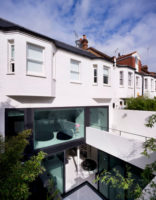This summer may be the busiest of Andy Klemmer’s life. Two buildings for which his firm, the New York-based Paratus Group, serves as project director—the Pérez Miami Art Museum, by Herzog & de Meuron, and an addition to the Kimbell Museum, in Fort Worth, by Renzo Piano—are racing toward fall openings, turning the New Yorker into a Florida-Texas commuter.
 |
| Photo courtesy Paratus Group Andy Klemmer |
He founded the company in 1997, the year Frank Gehry’s Guggenheim Bilbao, for which he served as owner’s rep, debuted. Subsequent projects have included SANAA’s Glass Pavilion at the Toledo Museum of Art as well as a series of museums by Piano, of which the 90,000-square-foot “Piano Pavilion” at the Kimbell is the latest. Along the way, he has won architects over to his management style. “If all clients had such reps, there would be better architecture all over the place,” says Christine Binswanger, the Herzog & de Meuron partner in charge of the Miami project. Klemmer spoke with RECORD by phone from the Kimbell site.
How is the project going?
The building is 97% dried in. Now we can get inside the galleries, and begin to place the interior finishes.
The opening is scheduled for November 27. Is it going to be a squeaker?
It will be a scramble and of course everyone wants more time and more money, but we are not giving in on either. Deadlines are good.
What has been the biggest challenge?
The contractor is used to working with local subs. But in this case, there are subcontractors from Germany, Italy, and Canada. That raises issues of distance, of currency fluctuations, and of differing business practices. Our job is to help the contractor through somewhat difficult subcontracts, but hold it responsible at the same time.
Did the desire to make the building perfect—it stands alongside Louis Kahn’s masterpiece—complicate the schedule?
Yes. Very late in the game (we were about 75% done with CD’s) Renzo changed the primary building material from travertine to concrete. And not just any concrete. He wanted to match the concrete that Ando had created in Venice for the Pinault museum at the Punta della Dogana, but there the concrete walls were just interior partitions. What we were trying to do was far more complex. We brought in the Dottor Group, the concrete consultant from Venice who had worked on Ando’s building. But concrete is always local: the sand is local, the gravel is local, the Portland cement is local, and so a lot of experimentation was required on the site.
How has it worked out?
I think we’ve poured maybe the best concrete walls in the United States. From a foot away, it looks like Carrara marble.
Are there similar concerns in Miami?
There we emphasized the concrete finish a little less, but it’s a more structurally ambitious building. In both cases, when concrete is your finish inside and out, it means the location of every light switch, every vent, every door jamb, has to be worked out before you can pour the structure of the building. So both of these jobs went through the very painful realization that all the coordination would have to be front-loaded.
And that job is also on a tight schedule?
When we were finishing CD’s, the general contractor’s gmp (guaranteed maximum price) came in $6 million over budget. It took a lot of negotiation to get it back to the figure we had all agreed on, and during that negotiation we lost precious time. It’s been a constant struggle to make up that time.
But you’ll make the deadline?
The board was always clear that the building had to be open for Art Basel 2013 [which begins on December 5]. And it will.
How is Paratus, as a project director, different from an owner’s rep?
In addition to managing relationships with the designers and builders, we are involved in everything from graphics to legal services. We move from excavation to exhibition design, sometimes in the same day.
Do you ultimately favor the owner?
Our job is to sit between the owner, the builder, and the architect and help guide them over the finish line. If you do your job right, all of them are happy. That’s the goal. It’s not to take a pound of flesh out of one person at the expense of the other
So architects aren’t suspicious of you?
Architects like the organization we bring to their projects. After we had worked with him on the California Academy of Sciences and the Morgan Library, Renzo Piano persuaded the Isabella Stewart Gardner Museum to hire us. He had already been on the job for two years. And he trusted us to help the client write a program, and to set a budget so that he had a target to hit.
Doesn’t hiring an owner’s rep cost money that could be spent on architecture?
Our fee is dwarfed by the money we save. At the Gardner, we came in $3.9 million under budget. That was cash back to the client. At the Morgan, we were $400,000 over budget, on a budget of $102 million. That’s .4 percent over budget, even though, after September 11, building material costs went up. The board couldn’t believe it. And in Miami, we set a budget of $650 a square foot, back in 2006. We’re going to finish the building for under $700 a square foot in 2013. That’s an amazing accomplishment for a museum.
Did sticking to the budget in Miami hurt the building?
I think the building will be stronger for it.



Post a comment to this article
Report Abusive Comment